Kale
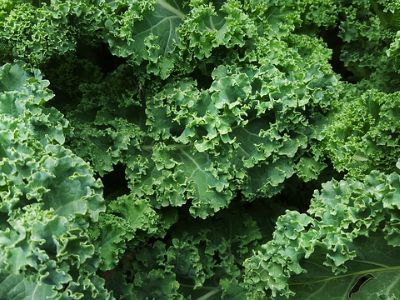
Preparation: Step-by-Step
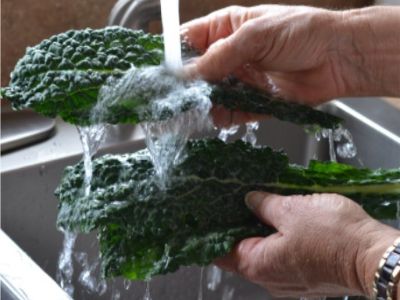
Wash hands. Thoroughly rinse kale to remove any dirt. Dry with a towel or in a salad spinner. Rewash kale if needed.
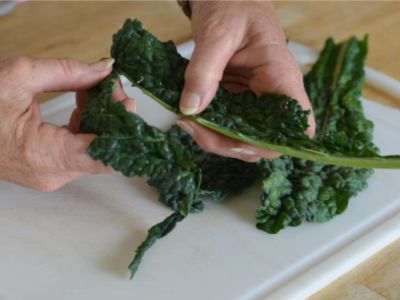
Cut off end of stems using a knife. For large leafed kale, slice on both sides of the stem to remove. Remove the stem and discard.
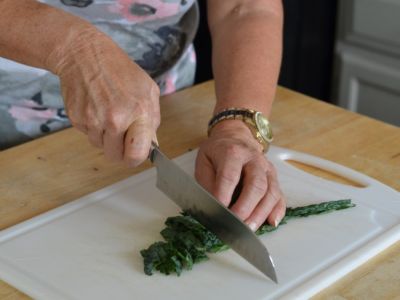
Stack greens and slice into 1/4‐ to 1/2‐ inch sections. Tenderness can be achieved by massaging finely cut greens with acidic dressing.
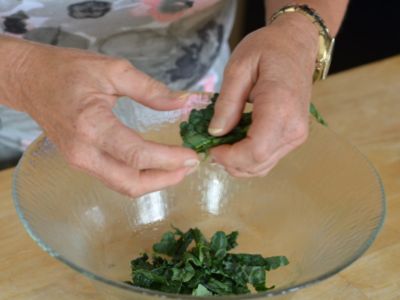
Smaller‐leafed kale can be hand torn or left whole.
Grow.
- Grow.
Direct seed or transplant kale when soil temperatures have reached a minimum of 40°F. Plant seeds ¼ to ½ inch deep with approximately 8‐inch spacing between plants and 18‐30 inches between rows. Kale is a cool season plant and does not thrive in high summer heat.
A late season crop can be achieved by planting 6 to 8 weeks prior to the first fall frost. Fertilize
if plants exhibit stunted growth or yellow foliage. Plenty of water will promote tender leaves.
Visit msuextension.org for more information or contact your local MSU Extension office.
Harvest.
- Begin harvesting kale when several leaves have developed. Select older, larger
leaves initially as plants will continue to grow through the season. As plants mature and
temperatures warm, older leaves may become tough and bitter, requiring more frequent
harvest or selection of younger leaves.
- Choose small to medium leaves with a dark green appearance. Avoid brown, yellow, wilted
or slimy leaves.
- Store kale unwashed in a bag in the coolest part of the refrigerator for 3‐5 days.
- Kale is a nutrient packed vegetable, rich in Vitamins A, C, K and B6 and contains
significant
amounts of potassium, calcium, iron and manganese. It is also a good source of dietary
fiber, contains no cholesterol and minimal amounts of calories and sodium. Like other leafy
greens, it is rich in phytochemicals which may help prevent cancer and other diseases.
Blanch or Boil.
- Cover kale with water and bring to a boil. Remove dried or thick stems and place the
kale into the boiling water to
blanch 5‐8 minutes or until desired tenderness.
Braise.
- Cut kale to desired size. Remove dried or thick stems. Drizzle cooking oil in a heated
pan, add seasonings if desired. Cook over
low heat for about 20 minutes, or until desired tenderness.
Preserve.
- For more information on preserving kale, read MontGuides Drying Vegetables and Freezing
Vegetables. Visit
www.msuextension.org/nutrition and click on the food preservation link or contact your Extension office.
Roast.
- Cut kale to desired size. Place on foil‐lined baking sheet and drizzle with olive
oil and seasoning. Bake at 300°F for 12‐15 minutes
or until crispy.
Salad
- Add raw to salads for added flavor, texture and visual appeal. Tenderness can be achieved
by massaging finely cut greens with
acidic dressing. Add in nuts, seeds or dried fruit for additional flavor and texture.
Sauté.
- Cut kale to desired size. Remove dried or thick stems. Drizzle cooking oil in a heated
pan, add seasonings if desired. Cook by
stirring over high heat until desired tenderness, about 5‐8 minutes.
Season.
- To enhance flavor, experiment with low‐sodium seasonings such as basil, bay leaf,
celery seed, garlic, oregano, tarragon or
thyme.
Soup or Entrée.
- Add kale to soups and entrees such as lasagna, quiche, or pizza.
Steam.
- Remove dried or thick stems. Place kale in a pan with a small amount of water and
seasonings. Cook on medium heat for 2‐4
minutes, depending on size and age of greens, until desired tenderness.
For More Information:
Montana State University Extension: msuextension.org
MSU Extension Master Gardener: mtmastergardener.org
MSU Extension Food and Nutrition: nutrition.msuextension.org
MSU Extension Nutrition Education Programs: buyeatlivebetter.org
Date of Publication: November 2015
